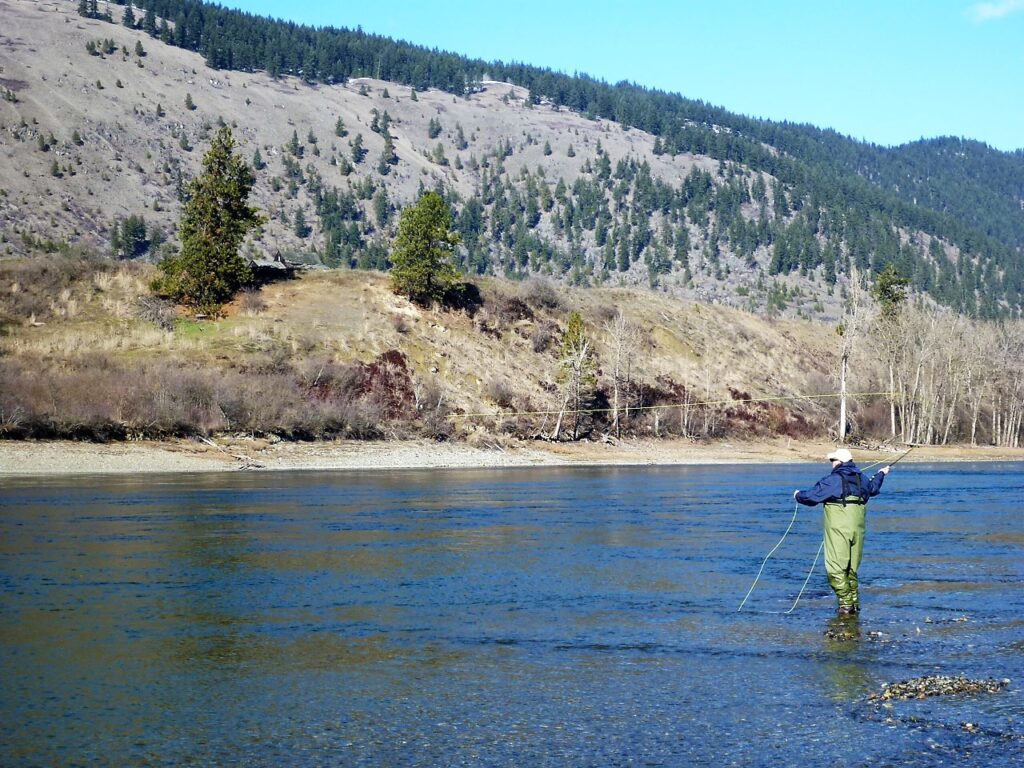Caddisflies produce one of the most prolific and prolonged aquatic insect hatches found in rivers. They belong to the insect order Trichoptera, a name derived from the Greek for “hairy wing.” This refers to their adult wings, which are covered in hair, unlike the scales of the closely related terrestrial order of butterflies and moths, Lepidoptera. Both rivers and lakes are home to over 1,200 species of caddisflies, but their largest diversity is found in flowing waters.
Caddisfly Lifecycle
Caddisflies undergo a complete metamorphosis or life cycle that includes larval, pupal, and adult stages. The larvae are found living in the benthic (bottom) zone of rivers and streams. Turning over a submerged river rock will often reveal several larvae, either in a free-crawling stage, or hidden within a case built of pebbles or bits of detritus that is called a larval retreat. Larvae are typically grazers, feeding on algae and other decomposing plant matter. Prime larval habitat is the shallow, riffle areas of streams, where water tumbling over a rocky or boulder-strewn substrate creates an oxygen-rich environment for both the larvae and the algae they feed on.

Caddis larvae grow and transform into the pupal stage while within the larval retreat. Upon maturation, the pupae break out of the larval retreat and, using a pair of elongated and feathered hind legs, swim quickly to the surface of the river to emerge as adult caddisflies. The newly emerged adult, which has crawled out of the pupal shuck, drifts downstream for several seconds while drying its wings off, and then flies off to shoreline vegetation. Adult caddisflies mate, and egg-laden females fly back to the river to deposit the next generation.

Matching the Lifecycle Stage for Fishing Success
Trout and other fish species will actively search out both free-swimming and cased caddis larvae. However, the most intense feeding activity occurs during the pupal swim to the surface, and as the newly emerged adults are still sitting on the water. Larval, pupal, and adult caddisfly imitations can be fished quite successfully using a floating fly line. The key is presenting each life stage in the proper depth zone of the river.
Caddisfly Larval Patterns
Larval patterns, which are often weighted, should be presented as close to the river bottom as possible. Casting larval patterns (like a bead-headed Serendipity, or Czech nymphs) upstream, and allowing them to sink while drifting back downstream to you, is a great way get the fly down and drifting in a natural fashion.
Caddisfly Pupal Patterns
Pupal patterns should be presented in a way that the fly is swimming up through the water on a gradual angle, just like real pupae. The Sparkle Caddis Pupa, Squirrel Nymph, and Flashback Caddis Nymph are all realistic pupal imitations that can be presented by casting down and across, and then mending the fly line to maintain a drag-free drift.

Caddisfly Floating Patterns
Floating patterns like the Elk Hair Caddis, Goddard Sedge, and Humpy are all good imitations of adult caddisflies. As with imitations of the larva and pupa, the size of the adult fly should match that of the real caddisfly. It will be quite obvious when the trout are taking adult caddisflies: you will see real bugs drifting down the river, then big, splashy riseforms occurring as one adult after another is eaten. Quite often, a specific fish will maintain a certain position in the current, and regularly rise to take an adult off the surface. This is a fish to target, as it is in a known position – and willing to feed. It is critical to present adult caddisfly patterns with a drag-free drift. Any unnatural movement, or pull of the floating fly, will warn the trout that this bug is not real.

Caddisfly emergences can occur from late spring right through the summer. It’s often an evening hatch, which adds an exciting end to a day on the river.
Author: Brian Chan, Freshwater Fisheries Society of BC Ambassador
Photo Credit: Brian Chan, Danie Erasmus, Steve Olson
